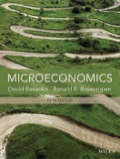
(a)
The objective function for the given problem.
Answer to Problem 1.17P
The objective function for the given problem is to minimize
Explanation of Solution
The objective function is the relationship that is maximized (or minimized) by the decision-maker.
Here, in the given case, the firm is seeking to minimize the total cost to operate plant one and two. Therefore, the objective function will be:
(b)
The constraints for the given problem.
Answer to Problem 1.17P
The constraints for the given problem is:
Explanation of Solution
A constraint is a restriction that will be placed on the firm.
Here, in the given case the firm will have 1 million metric tons of emission. Therefore, the constraint can be given as:
(c)
The statement of constrained optimization.
Answer to Problem 1.17P
The statement of constrained optimization is:
Explanation of Solution
A statement of constrained optimization states the kind of functions a decision-maker wants to minimize or maximize along with the constraints.
In this, the perspective of the decision-maker must be considered.
In the given case, the objective function is
The given constraint is
. Therefore, the statement for the constraint optimization can be given as:
(d)
The emission level from each plant chosen by the firm.
Answer to Problem 1.17P
The emission level from each plant chosen by the firm is given as:
| Emission plant 1 (X) | TC plant 1 | Emission plant 2 (Y) | TC plant 2 | TC |
| 0 | $490 | 1,000,000 | $10 | $500 |
| 250,000 | $360 | 750,000 | $40 | $400 |
| 500,000 | $250 | 500,000 | $90 | $340 |
| 750,000 | $160 | 250,000 | $160 | $320 |
| 1,000,000 | $90 | 0 | $250 | $340 |
Explanation of Solution
The allocation of operating cost for plant 1 and plant 2 can be represented in the following tabular form:
| Emission plant 1 (X) | TC plant 1 | Emission plant 2 (Y) | TC plant 2 | TC |
| 0 | $490 | 1,000,000 | $10 | $500 |
| 250,000 | $360 | 750,000 | $40 | $400 |
| 500,000 | $250 | 500,000 | $90 | $340 |
| 750,000 | $160 | 250,000 | $160 | $320 |
| 1,000,000 | $90 | 0 | $250 | $340 |
From the above table, it is concluded that when X =750,000 metric tons and Y = 250,000 metric ton, then the total operating cost is minimized.
Want to see more full solutions like this?
Chapter 1 Solutions
EBK MICROECONOMICS
- As indicated in the attached image, U.S. earnings for high- and low-skill workers as measured by educational attainment began diverging in the 1980s. The remaining questions in this problem set use the model for the labor market developed in class to walk through potential explanations for this trend. 1. Assume that there are just two types of workers, low- and high-skill. As a result, there are two labor markets: supply and demand for low-skill workers and supply and demand for high-skill workers. Using two carefully drawn labor-market figures, show that an increase in the demand for high skill workers can explain an increase in the relative wage of high-skill workers. 2. Using the same assumptions as in the previous question, use two carefully drawn labor-market figures to show that an increase in the supply of low-skill workers can explain an increase in the relative wage of high-skill workers.arrow_forwardPublished in 1980, the book Free to Choose discusses how economists Milton Friedman and Rose Friedman proposed a one-sided view of the benefits of a voucher system. However, there are other economists who disagree about the potential effects of a voucher system.arrow_forwardThe following diagram illustrates the demand and marginal revenue curves facing a monopoly in an industry with no economies or diseconomies of scale. In the short and long run, MC = ATC. a. Calculate the values of profit, consumer surplus, and deadweight loss, and illustrate these on the graph. b. Repeat the calculations in part a, but now assume the monopoly is able to practice perfect price discrimination.arrow_forward
- how commond economies relate to principle Of Economics ?arrow_forwardCritically analyse the five (5) characteristics of Ubuntu and provide examples of how they apply to the National Health Insurance (NHI) in South Africa.arrow_forwardCritically analyse the five (5) characteristics of Ubuntu and provide examples of how they apply to the National Health Insurance (NHI) in South Africa.arrow_forward
 Principles of Economics 2eEconomicsISBN:9781947172364Author:Steven A. Greenlaw; David ShapiroPublisher:OpenStax
Principles of Economics 2eEconomicsISBN:9781947172364Author:Steven A. Greenlaw; David ShapiroPublisher:OpenStax

 Managerial Economics: Applications, Strategies an...EconomicsISBN:9781305506381Author:James R. McGuigan, R. Charles Moyer, Frederick H.deB. HarrisPublisher:Cengage Learning
Managerial Economics: Applications, Strategies an...EconomicsISBN:9781305506381Author:James R. McGuigan, R. Charles Moyer, Frederick H.deB. HarrisPublisher:Cengage Learning
 Microeconomics: Private and Public Choice (MindTa...EconomicsISBN:9781305506893Author:James D. Gwartney, Richard L. Stroup, Russell S. Sobel, David A. MacphersonPublisher:Cengage Learning
Microeconomics: Private and Public Choice (MindTa...EconomicsISBN:9781305506893Author:James D. Gwartney, Richard L. Stroup, Russell S. Sobel, David A. MacphersonPublisher:Cengage Learning





